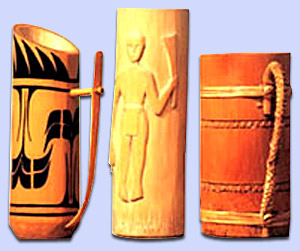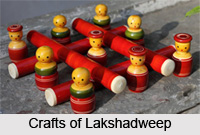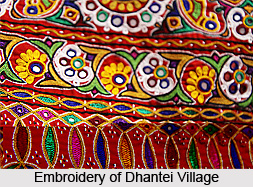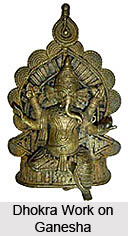 Dhokra art is one of the earliest known methods of non-ferrous metal casting known to human civilization. The oldest form of metal casting `Dhokra` is popular because of its primitive simplicity. This art style is a specialty of semi tribal communities of central and eastern India in the states of Madhya Pradesh, West Bengal, Odisha and parts of Vindhya Range. It is a very important handicraft because of its more or less exclusive folk character. The Dhokras of Bihar, Odisha, and West Bengal are distant cousins of the Madhya Pradesh. They all perhaps belong to a tribal group of that area. The artisans of this art are called Dhokras.
Dhokra art is one of the earliest known methods of non-ferrous metal casting known to human civilization. The oldest form of metal casting `Dhokra` is popular because of its primitive simplicity. This art style is a specialty of semi tribal communities of central and eastern India in the states of Madhya Pradesh, West Bengal, Odisha and parts of Vindhya Range. It is a very important handicraft because of its more or less exclusive folk character. The Dhokras of Bihar, Odisha, and West Bengal are distant cousins of the Madhya Pradesh. They all perhaps belong to a tribal group of that area. The artisans of this art are called Dhokras.
History of Dhokra
Dhokra art has a rich history in India, tracing back to 4000 years. One of the earliest known lost wax artifacts is the dancing girl of Mohenjo-daro. The technique was used thousands of years back to cast non-ferrous metals like copper to make artifacts. Some old artisans also used alloys like brass or bronze. Brass is a mixture of zinc and copper, while bronze is an alloy of tin and copper. The lost wax technique for casting of copper based alloys has also been found in China, Egypt, Malaysia, Nigeria, Central America, and other places.
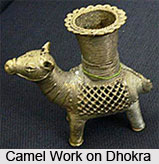 Procedure of making Dhokra
Procedure of making Dhokra
The Dhokras use lost-wax casting process to cast hollow brass objects and images. The essence of the process is to model the object in wax, each one individually, around a hardened clay core which has approximately the shape of object to be cast. Layers of soft, refractory material are laid over wax model and hardened into a mould. The wax between core and mould is lost or burnt out as mould is heated. Then molten metal takes its place and hardens between the core and inner surface of mould which holds a negative impression of the wax model in all its detail. The outer surface of hardened metal, therefore reproduce the shape and details of original wax model, with the core producing hollow interior. The hard core and mould become spongy and soft on firing and are easily removed.
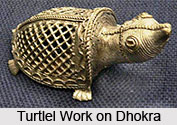 Dhokra Handicrafts
Dhokra Handicrafts
Made by tribals, Dhokra is notable for its strength and shapeliness of design. Its motifs are mostly drawn from folk culture. While among the animals, the elephant is most popular, other motifs include human heads, kings, manas or miniature replica of measures, containers with lids, with or without locking devices, idols of deities like Ganesh and Durga, lamps, and lamp stands. The lamps or lamp stands are being made in several intricate designs in the shape of trees and branches with as many as hundred lamps in one stand. Of late some utilitarian articles like candle stands, ash trays and pen stands are also being made keeping the essential folk design intact. The product of dhokra artisans are in great demand in domestic and foreign markets. Dhokra horses, elephants, peacocks, owls, measuring bowls, and lamp caskets etc., are highly appreciated.



